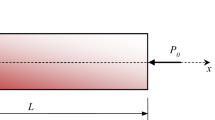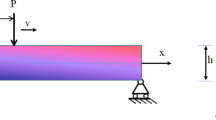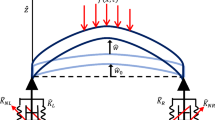Abstract
In the paper, an anisotropic Green’s function based hybrid finite element was developed for solving fully plane anisotropic elastic materials. In the present hybrid element, the interior displacement and stress fields were approximated by the linear combination of anisotropic Green’s functions derived by Lekhnitskii formulation, the element frame fields were constructed by the interpolation of general shape functions widely used in the conventional finite element, and then they are linked by a new double-variable hybrid functional. Because the approximated interior fields exactly satisfied the governing equations related to anisotropic elasticity, all integrals in the present hybrid functional were performed along the element boundary and theoretically arbitrary hybrid polygonal element can be constructed. Finally, the present hybrid polygonal element with four edges was verified by making comparison of numerical results and exact solutions in a cantilever composite beam made with angled lamina.
Similar content being viewed by others

References
E. Carrera, Theories and finite elements for multilayered, anisotropic, composite plates and shells, Archives of Computational Methods in Engineering, 9 (2) (2002) 87–140.
A. M. O'Mahony, J. L. Williams and P. Spencer, Anisotropic elasticity of cortical and cancellous bone in the posterior mandible increases peri-implant stress and strain under oblique loading, Clinical Oral Implants Research, 12 (6) (2001) 648–657.
Q. H. Qin, Hybrid-Trefftz finite element method for Reissner plates on an elastic foundation, Computer Methods in Applied Mechanics and Engineering, 122 (3) (1995) 379–392.
C. L. Tan and Y. L. Gao, Boundary element analysis of plane anisotropic bodies with stress concentrations and cracks, Composite Structures, 20 (1) (1992) 17–28.
E. Pan and B. Amadei, Fracture mechanics analysis of cracked 2-D anisotropic media with a new formulation of the boundary element method, International Journal of Fracture, 77 (2) (1996) 161–174.
Q. H. Qin and Y. W. Mai, BEM for crack-hole problems in thermopiezoelectric materials, Engineering Fracture Mechanics, 69 (5) (2002) 577–588.
Y. B. Wang and Y. Z. Sun, A new boundary integral equation method for cracked 2-D anisotropic bodies, Engineering Fracture Mechanics, 72 (13) (2005) 2128–2143.
H. Wang and Q. H. Qin, Hybrid FEM with fundamental solutions as trial functions for heat conduction simulation, Acta Mechanica Solida Sinica, 22 (5) (2009) 487–498.
H. Wang and Q. H. Qin, Fundamental-solution-based hybrid FEM for plane elasticity with special elements, Computational Mechanics, 48 (5) (2011) 515–528.
H. Wang and Q. H. Qin, Boundary integral based graded element for elastic analysis of 2D functionally graded plates, European Journal of Mechanics-A/Solids, 33 (2012) 12–23.
H. Wang and Q. H. Qin, Fundamental-solution-based finite element model for plane orthotropic elastic bodies, European Journal of Mechanics-A/Solids, 29 (5) (2010) 801–809.
T. A. Cruse, Boundary element analysis in computational fracture mechanics, Kluwer Academic Publisher, Dordrecht (1988).
P. Sollero and M. H. Aliabadi, Fracture mechanics analysis of anisotropic plates by the boundary element method, International Journal of Fracture, 64 (4) (1993) 269–284.
Q. H. Qin, Green's function and boundary elements of multifield materials, Elsevier, Oxford (2007).
O. C. Zienkiewicz and R. L. Taylor, The finite element method: Solid mechanics, Fifth Edition, Butterworth- Heinemann, Oxford (2000).
Q. H. Qin, Solving anti-plane problems of piezoelectric materials by the Trefftz finite element approach, Computational Mechanics, 31 (6) (2003) 461–468.
P. K. Banerjee and R. Butterfield, Boundary element methods in engineering science, McGraw-Hill, London (1981).
S. G. Lekhnitskii, Theory of elasticity of an anisotropic body, Holden-Day, San Francisco, USA (1963).
A. K. Kaw, Mechanics of Composite Materials, CRC Press, Boca Raton (2006).
Q. H. Qin, General solutions for thermopiezoelectrics with various holes under thermal loading, International Journal of Solids and Structures, 37 (39) (2000) 5561–5578.
Q. H. Qin and Y. W. Mai, Crack growth prediction of an inclined crack in a half-plane thermopiezoelectric solid, Theoretical and Applied Fracture Mechanics, 26 (3) (1997) 185–191.
H. Wang and Q. H. Qin, A new special element for stress concentration analysis of a plate with elliptical holes, Acta Mechanica, 223 (2012) 1323–1340.
Q. H. Qin and H. Wang, MATLAB and C Programming for Trefftz Finite Element Methods, CRC Press, Boca Raton (2009).
S. M. Chern and M. E. Tuttle, On displacement fields in orthotropic laminates containing an elliptical hole, Journal of Applied Mechanics, 67 (3) (2000) 527–539.
D. T. Reilly and A. H. Burstein, The elastic and ultimate properties of compact bone tissue, Journal of Biomechanics, 8 (6) (1975) 393–405.
Author information
Authors and Affiliations
Corresponding author
Additional information
Recommended by Associate Editor Gang-Won Jang
Qinghua Qin, born in 1958, is a Professor in Research School of Engineering, Australian National University. He has been researching on computational engineering, additive menufacturing, nanomechanics and mechanics of metamaterials.
Rights and permissions
About this article
Cite this article
Wang, H., Qin, QH. & Lei, YP. Green’s-function-based-finite element analysis of fully plane anisotropic elastic bodies. J Mech Sci Technol 31, 1305–1313 (2017). https://doi.org/10.1007/s12206-017-0229-7
Received:
Revised:
Accepted:
Published:
Issue Date:
DOI: https://doi.org/10.1007/s12206-017-0229-7



